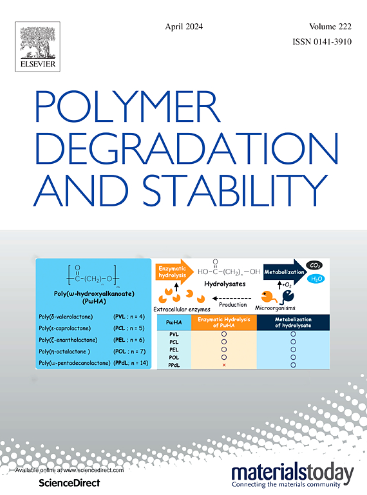The role of diffusion in the hydrolytic degradation of poly(lactic-co-glycolic acid): A molecular perspective
IF 6.3
2区 化学
Q1 POLYMER SCIENCE
引用次数: 0
Abstract
This research emphasizes the importance of internal surface erosion as a key factor in the hydrolytic degradation of PLGA (poly(D,L-lactic-co-glycolic acid)) providing an alternative view of the established surface and bulk erosion degradation modes. Using molecular dynamics (MD) simulations, this study reveals the role of water and oligomer diffusion during the degradation of PLGA and highlights the importance of water channels formed as the overall water content increases. We found that these continuous water channels play a crucial role in accelerating the transport of water and the release of degradation products from the polymer matrix, as the diffusion coefficients of water and small oligomers exhibit significant differences spanning 2 to 3 orders of magnitude between the water and polymer phases. Water follows a different diffusion mechanism than polymer fragments. The diffusion rate of the fragments up to a size of octamers was found to be size-dependent and reasonably well approximated by a 1/N behavior, in line with the Rouse model.

求助全文
约1分钟内获得全文
求助全文
来源期刊

Polymer Degradation and Stability
化学-高分子科学
CiteScore
10.10
自引率
10.20%
发文量
325
审稿时长
23 days
期刊介绍:
Polymer Degradation and Stability deals with the degradation reactions and their control which are a major preoccupation of practitioners of the many and diverse aspects of modern polymer technology.
Deteriorative reactions occur during processing, when polymers are subjected to heat, oxygen and mechanical stress, and during the useful life of the materials when oxygen and sunlight are the most important degradative agencies. In more specialised applications, degradation may be induced by high energy radiation, ozone, atmospheric pollutants, mechanical stress, biological action, hydrolysis and many other influences. The mechanisms of these reactions and stabilisation processes must be understood if the technology and application of polymers are to continue to advance. The reporting of investigations of this kind is therefore a major function of this journal.
However there are also new developments in polymer technology in which degradation processes find positive applications. For example, photodegradable plastics are now available, the recycling of polymeric products will become increasingly important, degradation and combustion studies are involved in the definition of the fire hazards which are associated with polymeric materials and the microelectronics industry is vitally dependent upon polymer degradation in the manufacture of its circuitry. Polymer properties may also be improved by processes like curing and grafting, the chemistry of which can be closely related to that which causes physical deterioration in other circumstances.
 求助内容:
求助内容: 应助结果提醒方式:
应助结果提醒方式:


